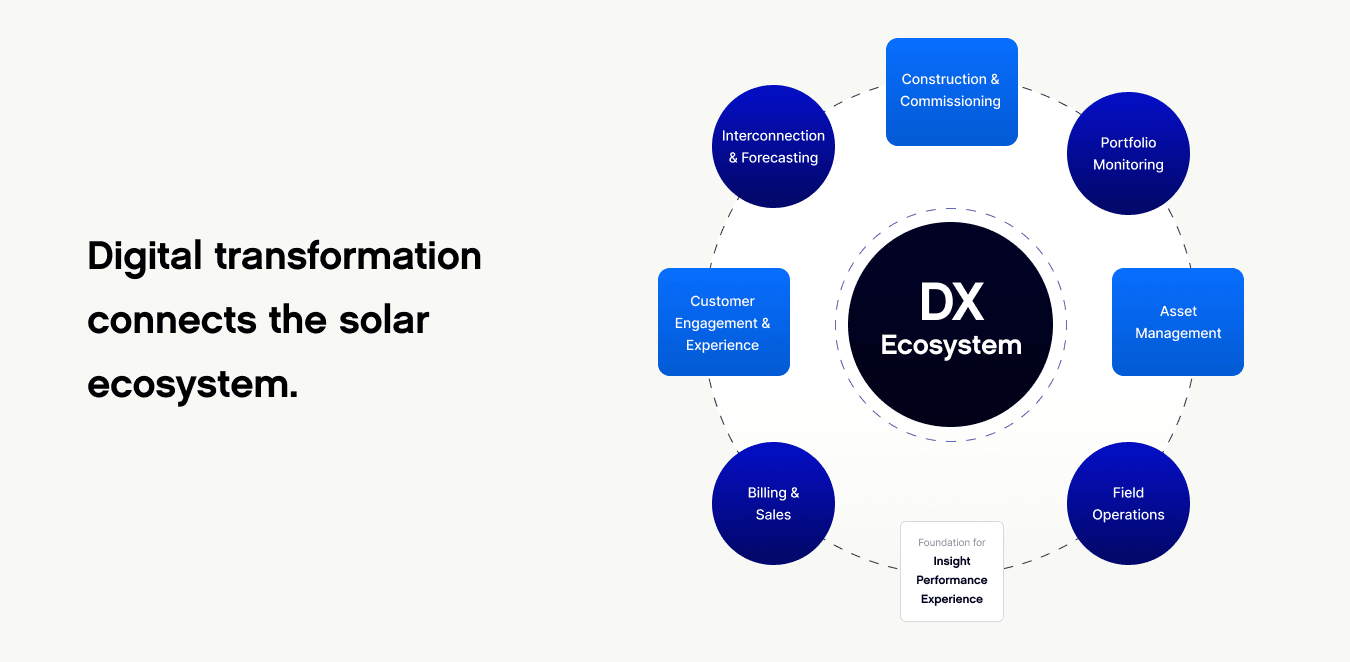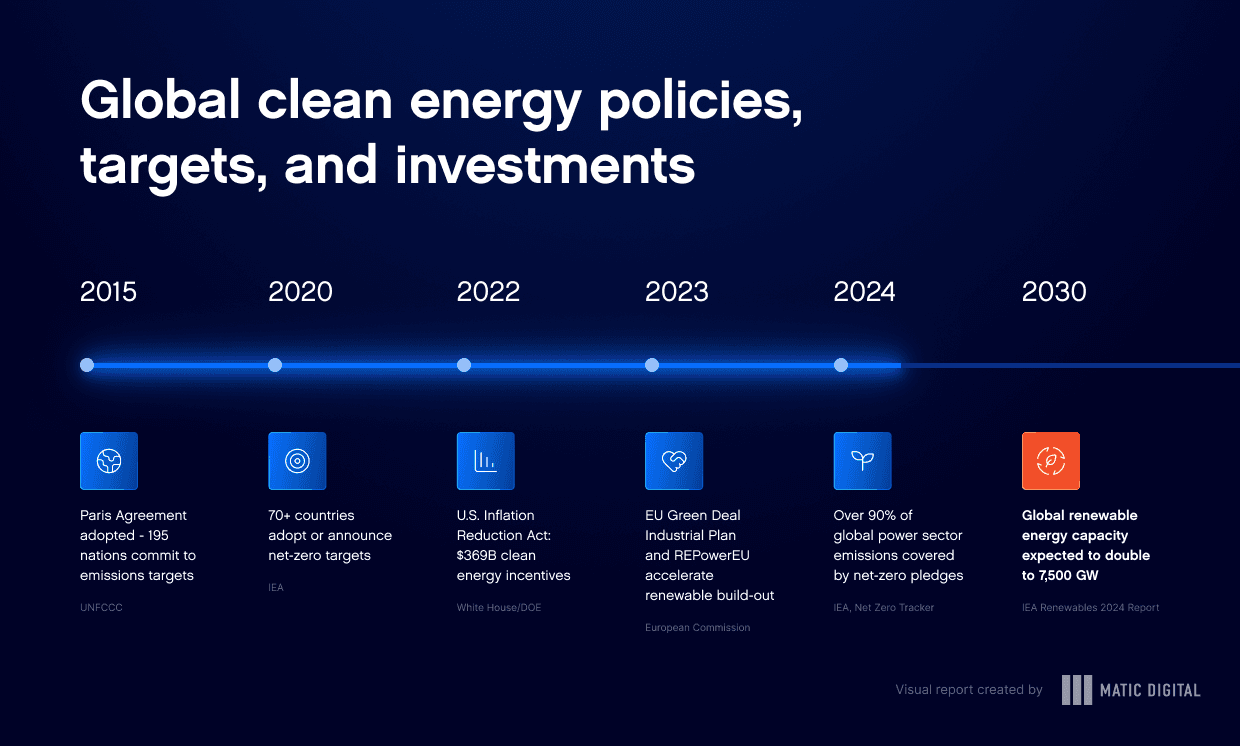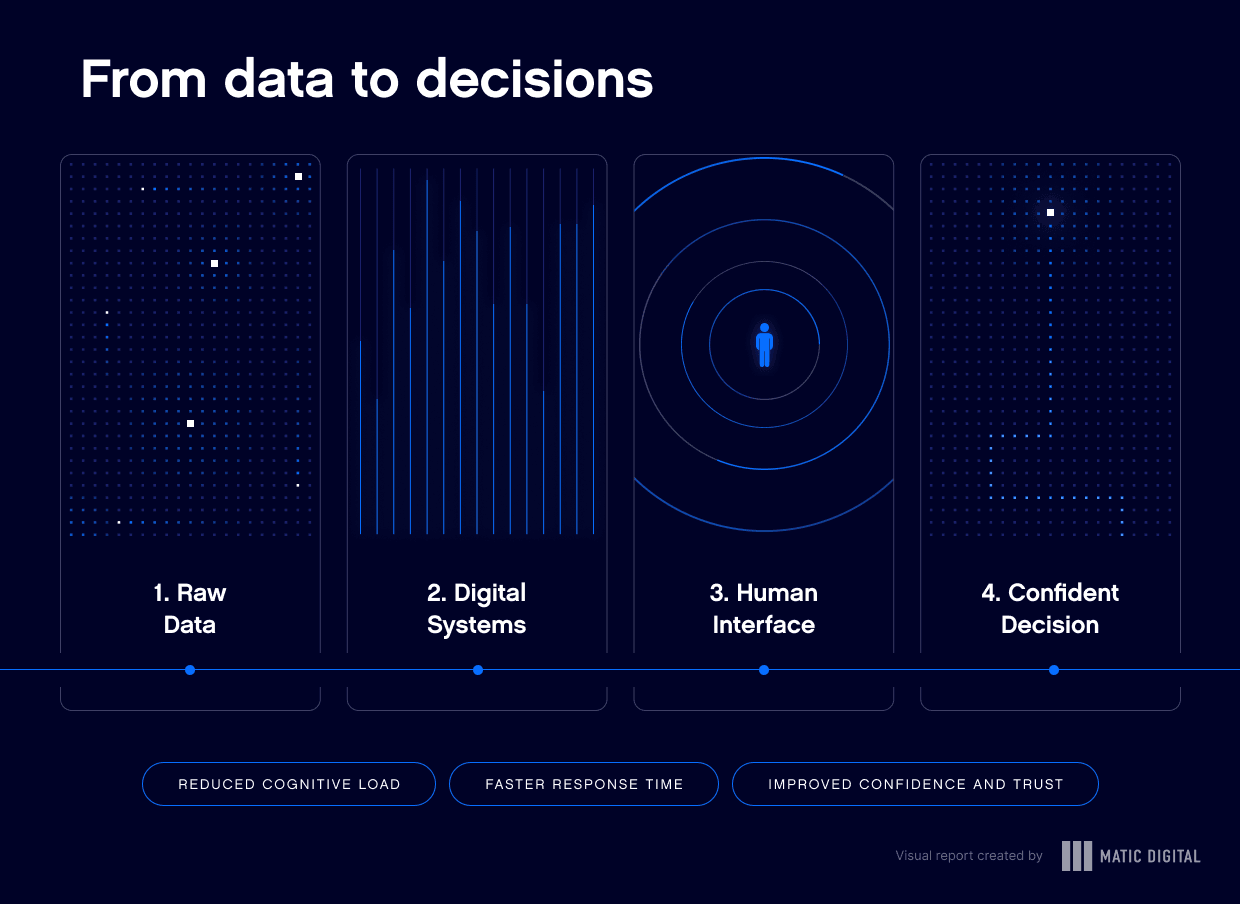0.00%

FeaturedInsights
Digital transformation in solar: A complete guide for energy leaders
The energy industry stands at a critical crossroads - and solar is at the center of it. As renewable energy reshapes power generation and distribution, digital transformation in the energy sector has become the line between operators who scale efficiently and those who stall. DX involves using digital technologies like AI, big data, IoT, and digital twins to improve the efficiency of clean energy systems. The goal of clean energy is to generate power without the negative environmental and climate impacts associated with burning fossil fuels.
Federal agencies, states, and organizations are working to advance clean energy by proactively developing and supporting innovative technologies, regulatory reforms, and policy initiatives that promote sustainability, reduce pollution, and improve energy efficiency. This progress is driven by collaboration across various offices, agencies, and organizations to support clean energy digital transformation. In addition to developing and supporting innovative technologies, these stakeholders are investing in and planning the expansion of electric transmission infrastructure and renewable energy projects, emphasizing strategic partnerships and readiness for renewable asset integration.
This guide explores how digital transformation in solar energy can accelerate energy-sector innovation specifically within utility-scale PV, community solar, and C&I portfolios. These strategies are revolutionizing operations, enabling the energy transition, and creating durable advantages for forward-thinking energy companies.
The global digital power utility market is forecast to reach $239.38B by 2028, up from $55.02B in 2021, underscoring the rapid pace of digitalization. Solar power capacity has doubled globally in the last three years, reaching 2 terawatts in 2024. We cover the adoption of advanced technologies and the strategic approaches behind digital transformation for the energy sector, with practical insight into how solar organizations can leverage innovation to stay ahead. Manufacturing plays a crucial role in producing energy-efficient and environmentally sustainable products, as well as contributing to industrial waste conversion for energy recovery. Digital solutions enable the seamless integration of distributed energy resources into a unified virtual power plant network. Some digital tools have been developed by the U.S. Department of Energy and the Department of Health and Human Services, further enhancing their credibility and reliability.
We cover the adoption of advanced technologies and the strategic approaches behind digital transformation for the energy sector, with practical insight into how solar organizations can leverage innovation, science, and engineering expertise to stay ahead.
Source: Fortune Business Insights, “Digital Power Utility Market Size, Share & Growth Report, 2021–2028”
Understanding digital transformation in the energy sector
Digital transformation in energy is a redesign of how companies operate, make decisions, and create value. In solar, it means integrating digital across the entire lifecycle:
Interconnection and forecasting
Construction and commissioning
Portfolio monitoring
Asset management
Field operations
Billing and sales
Customer engagement
Energy-efficient buildings
When done well, energy digitalization improves reliability, customer satisfaction, and operational efficiency. Strategies must be tailored to specific segments: utility-scale PV, distributed generation, community solar, and C&I each have unique data models, SLAs, and regulatory contexts.
The industry faces unprecedented pressure to modernize. Demand is rising not just from electrification and renewables, but from the surge in computing, cloud, and AI-driven workloads putting new stress on power systems. Climate commitments are accelerating the shift toward renewables, while aging infrastructure competes for finite capital. Wind and solar energy are projected to provide 60-80% of generation in the least-cost electricity mix by 2035 in some models. Geothermal and certain forms of biomass are also considered clean energy.
Solar operators also contend with interconnection queues, irradiance variability, curtailment risk, and margin pressure in O&M. Digitalization in solar energy requires investment in software, networks, and data platforms. In some regions, concentrated grid or supplier dynamics can slow innovation by limiting competition and cost reductions. Engineering expertise is essential for developing and maintaining these digital energy systems, ensuring they are robust, scalable, and secure. AI algorithms and big data analytics improve forecasting for renewable energy generation and energy demand, balancing the grid more effectively. Automation and cloud technologies modernize legacy systems and reduce manual errors in the energy transition.
Recent years have delivered real progress. Smart meters provide near real-time visibility into consumption and, in some programs, have driven double-digit improvements in energy management. On the supply side, inverter-level telemetry, digital twins of PV plants, and SCADA integration let operators simulate scenarios, identify underperformance, and optimize dispatch.
Cloud platforms now process massive volumes of sensor data across entire portfolios. These capabilities represent just the beginning of what’s possible when solar teams embrace digital innovation with focus and discipline.

Why digital transformation in energy matters
Energy companies that delay digital transformation risk falling behind competitors who leverage AI in energy management, analytics, and automation to achieve operational efficiency and capture market share.
Research suggests companies that actively implement digital technologies can reduce operating costs by 20–30% and increase productivity by 5–15%. For the solar industry, those numbers translate into higher capacity factors, reduced downtime, and better energy yield.
Traditional systems were designed for centralized fossil generation. Today’s distributed networks must accommodate intermittent renewable sources like solar and wind, while also transitioning to a zero-emission electric grid. Automated processes in smart substations and AI-powered grid systems help balance these fluctuations, maintaining reliability while reducing costs.
Beyond technical improvements, digital transformation in energy supports evolving customer expectations. Consumers now expect transparency around usage, personalized services, and more control over their energy mix. Meeting those expectations requires digital experience platforms that merge engagement, insight, and new business models such as peer-to-peer energy trading to EV charging networks. Energy efficiency programs, enabled by smart meters and digital tools, help customers manage their energy use and participate in broader sustainability initiatives.
The business case extends beyond efficiency. Digital transformation in solar energy unlocks new revenue streams and improves asset ROI through predictive maintenance, smart grid integration, and real-time analytics. Beyond an IT initiative, DX is a long-term strategy for sustainability, growth, and customer trust. These digital initiatives also enhance the quality of life and environmental quality for communities by supporting clean energy programs and reducing emissions.
Key drivers accelerating energy digitalization and transformation

The renewable energy revolution
The shift toward renewables creates massive opportunities and operational complexity. Integrating solar and wind means managing output that varies by weather and time of day. Digital forecasting and AI-based energy management systems have become essential to balance production and storage. Green hydrogen is emerging as a zero-carbon fuel produced using renewable energy sources via electrolysis.
According to McKinsey & Company, data centers and AI growth could push computing’s share of U.S. power demand from roughly 4% today to 12% by 2030, while the International Energy Agency projects that global data-center electricity use may more than double in the same period. That rising demand makes solar and distributed energy assets critical to system stability and promotes digital integration to indispensable.
Operators managing distributed assets in community solar to C&I portfolios now rely on IoT-enabled monitoring to trigger alerts and optimize production across sites. Implementing digital solutions is crucial for optimizing production and ensuring seamless grid integration. Digital platforms have become the connective tissue between the grid, generation assets, and market operations.
Grid modernization and smart infrastructure
Aging infrastructure wasn’t built for two-way power flows or distributed generation. Smart grid technologies transform passive infrastructure into dynamic systems that can reroute power, balance real-time load, and integrate renewables efficiently.
Smart meters provide granular visibility within homes, businesses, and facilities, enabling time-of-use pricing, demand forecasting, and grid optimization. Advanced sensors and machine learning in energy systems analyze voltage, frequency, and load conditions to forecast demand, detect faults, and optimize energy flow. Digital systems can also manage heat recovery and waste heat resources, harnessing heat from industrial processes or renewables to further improve overall grid efficiency.
This level of real-time control was impossible before digital transformation in the energy sector became mainstream.
Rising customer expectations and experience design
Energy customers now expect digital-native experiences including mobile apps, flexible billing, outage alerts, and transparent data reporting. Digital platforms integrate customer insights, self-service, and engagement across every channel. These platforms are also increasing access to clean energy and digital services for underserved communities, helping to bridge gaps in availability and equity.
Equally important, experience design is becoming a core differentiator. Well-designed interfaces reduce friction, improve trust, and shorten training for operators and field teams. A unified digital experience connects customers, employees, and partners under a cohesive brand system that signals reliability and innovation in equal measure.
Energy companies that combine digital strategy and brand design gain an edge: adoption accelerates, engagement deepens, and every digital interaction reinforces credibility.
Core technologies powering digital transformation in energy
Internet of Things (IoT), AI and sensor networks
IoT devices form the nervous system of energy digitalization. Sensors across wind farms, solar arrays, and substations generate continuous data streams about performance and conditions.
For solar operators, IoT sensors monitor irradiance, temperature, vibration, and output, feeding predictive maintenance algorithms that prevent downtime. For grid operators, these sensors enable visibility and automation — creating a self-healing grid that reroutes power instantly when issues occur.
Artificial intelligence and machine learning
AI turns energy data into insight. It powers demand forecasting, asset optimization, and predictive maintenance across the value chain.
Machine-learning models analyze consumption patterns, weather, and market signals to predict demand, reduce waste, and optimize generation. Predictive maintenance models catch early signs of component failure, extending asset life and reducing downtime.
For solar and renewable energy companies, AI enables smarter dispatch, more efficient maintenance, and better margin control.
Cloud computing and data platforms
Energy generates enormous data volumes. Cloud computing in energy provides the scalable infrastructure for collecting, storing, and analyzing it.
Modern cloud platforms unify siloed systems — operations, asset management, and customer engagement — into a single digital ecosystem. This integration enables cross-functional visibility and better decision-making.
Security remains paramount. Leading energy organizations deploy secure cloud architectures with encryption, identity controls, and threat detection to protect critical infrastructure.
Digital twins and simulation
Digital twins (virtual replicas of physical assets or systems) let operators simulate performance and plan proactively. For solar farms, they model every panel’s output under real-world conditions. For grid operators, they model stress tests, weather events, and expansion scenarios before implementation. Carbon capture and storage (CCS) technology is advancing to help reduce carbon output in hard-to-abate industries.
The result: lower risk, higher resilience, and smarter investment decisions. Digital twins exemplify how digital transformation in energy infrastructure bridges physical and virtual systems.
Experience and design systems
Every technology layer surfaces through an interface via dashboards, apps, and portals. A consistent design system ensures information looks and behaves predictably across tools.

For energy organizations, design is now infrastructure. It connects complex technology with human understanding. Cohesive visual and interaction patterns improve usability, accelerate adoption, and reinforce the brand’s credibility. Experience design turns digital transformation into something people trust and use every day.
In the context of clean energy digital transformation, a well-crafted design system does more than just create aesthetic consistency; it fosters intuitive navigation and seamless interaction across diverse platforms. This is crucial when operators, engineers, and customers rely on real-time data and analytics to make informed decisions. By standardizing interface elements such as color schemes, typography, and control behaviors, design systems reduce cognitive load, helping users quickly interpret complex information and respond effectively.
Moreover, design systems support scalability and agility in energy software development. As new features, tools, or modules are introduced, they can be integrated without disrupting the user experience, ensuring that digital transformation initiatives remain adaptable to evolving technology and market demands. This adaptability is essential for energy companies navigating rapid changes in renewable energy integration, grid management, and customer engagement.
Ultimately, investing in a robust design system aligns with broader goals of operational efficiency, user satisfaction, and brand differentiation. It empowers energy organizations to deliver digital solutions that are not only powerful but also accessible and trustworthy, advancing the clean energy transition through human-centered technology.
Energy storage solutions: Unlocking the full potential of solar
Energy storage solutions are rapidly becoming the linchpin for maximizing the value of solar energy and accelerating the clean energy transition. By capturing excess electricity generated during peak sunlight hours, advanced energy storage systems such as lithium-ion batteries and emerging technologies enable a reliable, round-the-clock power supply. This not only increases access to renewable energy for businesses and communities but also reduces dependence on fossil fuels, directly supporting efforts to lower electricity bills and carbon emissions.
For sectors with high energy demands, like data centers, energy storage is essential for maintaining consistent operations while minimizing energy consumption and environmental impact. Companies across the industry, including leaders like Con Edison, are investing in large-scale battery storage projects to support the growth of solar and ensure a more resilient, sustainable future. These solutions help balance supply and demand, making clean energy more reliable and affordable for all.
As the energy landscape evolves, integrating energy storage with solar is key to building a flexible, future-ready grid. By supporting the transition to clean energy, storage solutions empower companies and communities to participate in the fight against climate change, paving the way for a more sustainable and reliable power system.
Policy and regulation: Navigating the evolving energy landscape
As the global community accelerates the clean energy transition, policy and regulation have become powerful catalysts for change. Governments and regulatory bodies are setting ambitious targets to reduce carbon footprints, phase out fossil fuels, and increase access to renewable energy sources such as solar, wind, and biomass. These evolving frameworks are essential for driving the development and implementation of clean energy projects that are both energy efficient and scalable.
Forward-thinking policies—ranging from renewable portfolio standards to tax incentives and streamlined permitting—are making it easier for companies to invest in and deploy clean energy solutions. By establishing clear guidelines and support mechanisms, regulators help de-risk investments, encourage innovation, and ensure that new projects align with broader sustainability goals. This regulatory support is especially critical for emerging technologies and business models that can deliver affordable, reliable, and energy-efficient power to communities and businesses.
The transition to a sustainable future requires a combination of robust policy, effective regulation, and ongoing technological development. Collaboration between companies, governments, and other stakeholders is vital to ensure that regulations keep pace with innovation and market needs. By working together, these groups can create an environment where clean energy projects thrive, energy efficiency is prioritized, and the benefits of renewable energy are accessible to all.
As the energy landscape continues to evolve, staying informed and engaged with policy developments is essential for companies looking to lead in the clean energy sector. Proactive engagement with regulatory processes not only supports compliance but also helps shape the future of energy—ensuring that the transition to renewables is both effective and equitable.

Human experience: The last mile of digital transformation
As the energy sector becomes increasingly digital, the human experience determines whether transformation succeeds. Technology creates possibility — design turns it into behavior.
Operators, field teams, and customers rely on platforms and dashboards every day. A well-designed interface doesn’t just display data; it guides action, builds confidence, and reduces cognitive load. Digital transformation efforts also enhance collaboration with stakeholders and communities, ensuring that solutions are inclusive and effective.
Many energy organizations modernize infrastructure but overlook the adoption experience. Smart applications and brand systems create the connective tissue between strategy, design, and technology — keeping every team aligned and every interaction consistent. Customers and field teams can get involved in shaping digital transformation initiatives by providing feedback and participating in pilot programs.
In energy, reliability and trust are non-negotiable. A cohesive digital experience is part of that promise. Companies that design for clarity and confidence, not just capability, will lead the next decade of transformation.

Overcoming challenges and barriers in solar digitalization
While digitalization is essential for advancing energy efficiency and the clean energy transition, the path to fully digital solar operations is not without obstacles. Key challenges include a lack of standardization across platforms, significant upfront investment requirements, and limited access to financing for new technologies. Legislative changes, such as the repeal of energy tax credits and incentives, could significantly impact the finance sector by affecting investment, increasing costs, reducing jobs, and undermining economic stability within the clean energy industry. These barriers can slow the adoption of digital solutions and hinder progress toward a more sustainable future.
To overcome these hurdles, collaboration between companies, governments, and other stakeholders is crucial. Joint efforts can drive the development of innovative business models and technologies that make solar digitalization more accessible and cost-effective. Investments in research and development, as well as targeted training and education programs for energy professionals—structured programs designed to support clean energy deployment, customer incentives, and infrastructure development—are vital for building the expertise needed to implement and scale digital solutions.
Policy support also plays a significant role. By enacting regulations and incentives that encourage the adoption of clean energy and digital practices, governments can help accelerate the transition. Additionally, integrating biomass and waste-to-energy technologies into the energy mix can further support sustainability goals and reduce waste.
Ultimately, overcoming these challenges requires a combination of strategic investment, cross-sector partnership, and a commitment to continuous development. By working together, the industry can unlock the full potential of solar digitalization and build a more energy-efficient, sustainable future.
Taking action: The digital transformation roadmap
Digital transformation in energy isn’t a one-time project. It’s a long-term framework for continuous improvement — one that defines outcomes, aligns architecture, and scales what works.
1. Define the digital vision and governance
Start with clarity. Define outcomes and how digital capabilities drive them towards improving uptime, accelerating interconnections, or elevating customer engagement.
2. Invest in the right foundations
Data and connectivity form the base of every energy digitalization initiative. Focus on scalable data platforms, secure networks, and cybersecurity frameworks that support multiple use cases.
3. Build a smart AI strategy, not just AI tools
AI in energy must be intentional. Build from data readiness and define clear use cases: forecasting, anomaly detection, dispatch optimization, and customer experience. Keep humans in the loop to validate insights and build trust in AI decisions.
4. Partner with purpose
Choose partners who understand energy’s unique constraints surrounding uptime, safety, regulation. The goal isn’t outsourcing transformation but accelerating internal capability.
5. Pilot small, scale deliberately
Start with high-value pilots, demonstrate measurable results, and replicate across regions or assets. Scaling is about repeatable success, not more software.
6. Embed continuous innovation
Make experimentation routine. Encourage operators and field teams to surface pain points and test digital solutions. Over time, innovation becomes part of how the organization operates.
Measuring success and impact in digital solar initiatives
Evaluating the effectiveness of digital solar initiatives is essential for ensuring that investments deliver real value and drive progress toward a sustainable future. Success can be measured by tracking key performance indicators such as energy use, reductions in carbon footprint, and cost savings achieved through energy-efficient practices. Regular assessments and data-driven analysis help companies and other stakeholders understand the impact of their efforts on the environment, local communities, and the broader economy.
By leveraging advanced analytics and transparent reporting, organizations can identify opportunities for improvement and refine their strategies to better support the clean energy transition. The development and implementation of new technologies such as wind, hydro, and energy-efficient solutions will further contribute to reducing greenhouse gas emissions and advancing clean energy goals.
Collaboration between the department of energy, companies, and other stakeholders is critical for developing programs and best practices that promote the adoption of solar and other renewable energy sources. Through ongoing measurement, innovation, and partnership, the industry can ensure that digital solar initiatives deliver meaningful benefits, support community development, and help build a more sustainable and energy-efficient future for all.
Conclusion: Seizing the digital energy future
The energy industry is being rebuilt in real time. What once relied on centralized generation and static systems now runs on data, design, and distributed intelligence.
From predictive maintenance and grid simulation to customer experience platforms and portfolio analytics, digital transformation in energy determines competitiveness. It enables efficiency, sustainability, and transparency that makes the energy transition work.
Global energy companies are projected to invest US $713 billion in grid digitalization over the next six years. The cost of inaction leads to inefficiency, missed opportunity, and erosion of market position, and cost substantial missed opportunities.
Leaders across marketing, operations, and technology must align on a shared vision. Build foundations, prove value early, and keep evolving.
The energy future is already digital. The question is whether your organization will help design it or react to it once it’s built.
Digital transformation in energy: By the numbers
(All figures from publicly available industry sources, 2023–2025)
Insight | Data Point | Source |
Global digital power-utility market growth | US $55.02 B (2021) → US $239.38 B (2028), CAGR 23.4 % | |
AI & data-center electricity demand | Global data-center electricity use projected to double by 2030; AI workloads growing ~30 % / yr | |
Digital adoption efficiency gains | Companies applying digitalization achieve 10–30 % cost reduction and 2–10 % productivity increase | |
Predictive maintenance impact | Reduces maintenance costs 25–30 %, equipment failures 70–75 %, downtime 35–45 % | |
Smart-grid market expansion | Expected to reach US $114 B by 2030 (from ~ US $43 B in 2022) | |
IoT penetration in energy assets | More than 1.3 B IoT endpoints in energy & utilities by 2030 |

About Matic
We're a B2B transformation agency creating strategic advantage through branding, websites, and digital products.
Closing thoughts
Solar’s next gains won’t come from bigger arrays alone. They’ll come from smarter systems that turn data into decisions, and decisions into performance. Build the foundations, design for people, and apply AI where it moves the needle. Start small, prove value, scale what works. Treat digital as a discipline, not a project. The teams that do this will run leaner portfolios, earn more trust, and lead the transition.


